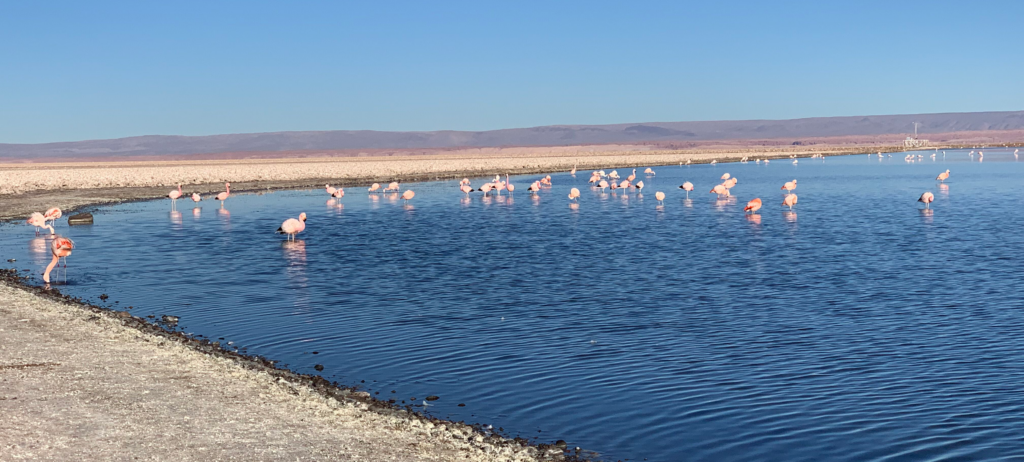Welcome to one of the windiest, wildest, weirdest, and most wonderful places on Earth: the Atacama Desert in Chile. Nestled deep in the heart of northern Chile, this vast, lunar-like landscape stretches out in every direction, leaving visitors in awe of its beauty, harshness, and otherworldly charm. The Atacama is a place like no other—a destination that defies expectations and invites you to explore its rugged terrain, from salt flats to volcanoes, and everything in between.
Where Exactly Is This Lunar Landscape?
The Atacama Desert is located in the middle of what seems like nowhere. If it’s true that your latitude determines your attitude, then heading way down south to one of the driest places on earth is bound to change your perspective. Parts of the Atacama have never seen recorded rainfall, making it one of the driest places on the planet. And with the cold morning winds biting at our faces and hands, it’s also one of the chilliest.
But it’s not just the climate that makes the Atacama Desert unique; it’s the landscape itself. Imagine standing in the middle of a vast, open desert, surrounded by towering volcanoes. In every direction you look, you can see the craggy peaks of ancient, dormant volcanoes. Some say there are at least four visible from any given spot in the desert. It’s one of those bucket-list places you simply must see when you visit Chile.
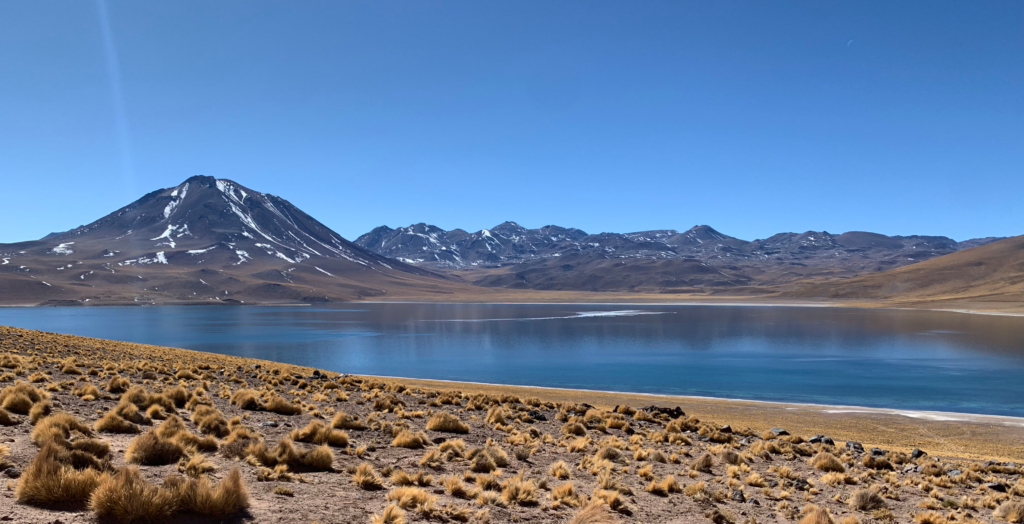
Getting to San Pedro de Atacama
Adventures in the Atacama Desert begin in the dusty desert town of San Pedro de Atacama. Now, this place does take some time and effort to get to. First, you take an hour-and-a-half flight from Santiago to a small airport in the town of Calama. From there, it’s a little over an hour drive to get to San Pedro de Atacama. There’s a few different ways to do it: taxi, hotel shuttle or rent a car. If you arrive in the middle of the day, the hotel shuttle is usually available and your hotel can easily line that up. Depending on where you’re staying there might be a small charge, but it’s like $15/person range. Not bad. If you arrive late, like we did, they can arrange a taxi, but that runs closer to $80. So arrange your flights accordingly.
This remote outpost feels like the edge of the world. We arrived in the dead of night, eager to begin our adventure. The chill in the air was biting, but nothing—not even the cold—was going to stand in the way of our mission to explore one of the most impressive landscapes on planet Earth.
Adventures in Atacama
We know picking the right tours can be tough. Hopefully, you’ll spend a few days here to get to enjoy everything there is to see. For our first one, we took an all day adventure through a number of spots, starting at 5 a.m. Loaded into a 16-passenger white van with a group of tourists from all corners of the globe, we set off down the lonely highway. Our first stop would give us a taste of the Chilean desert, and what a taste it was. The Atacama stretches for over a thousand miles along northern Chile’s Pacific coast, west of the Andes Mountains. Trapped between two mountain ranges, moisture from the Pacific and Atlantic oceans can’t reach this desert. The only moisture comes from fog that occasionally drifts in from the coast, making the Atacama the driest place on earth.
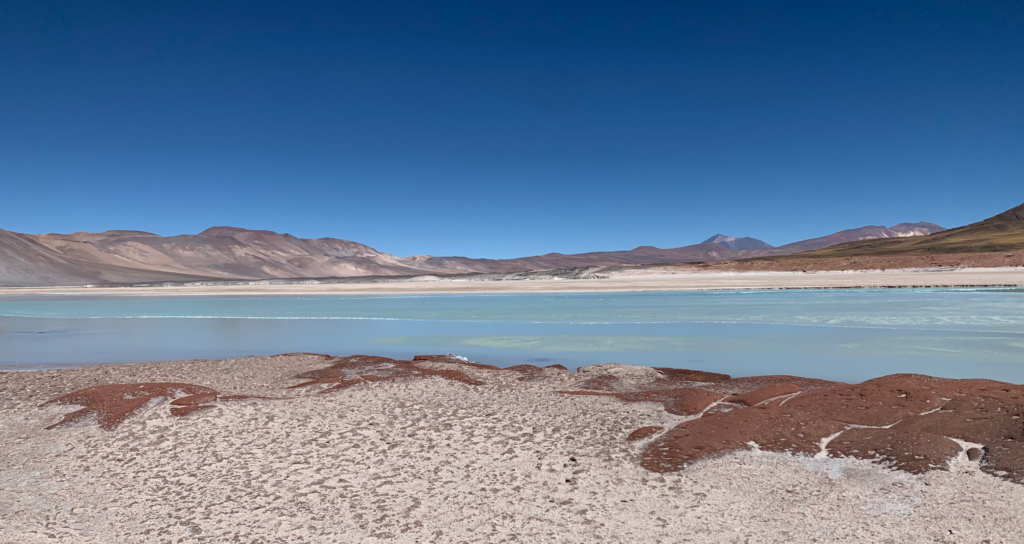
Los Flamencos National Reserve: A Desert Oasis
Our first stop of the day was Los Flamencos National Reserve, a place so remote and inhospitable that it seems otherworldly. As we stepped out of the van, we were greeted by a sight that seemed impossible: hundreds of flamingos wading in shallow lagoons, their bright pink feathers stark against the desolate backdrop of the desert.
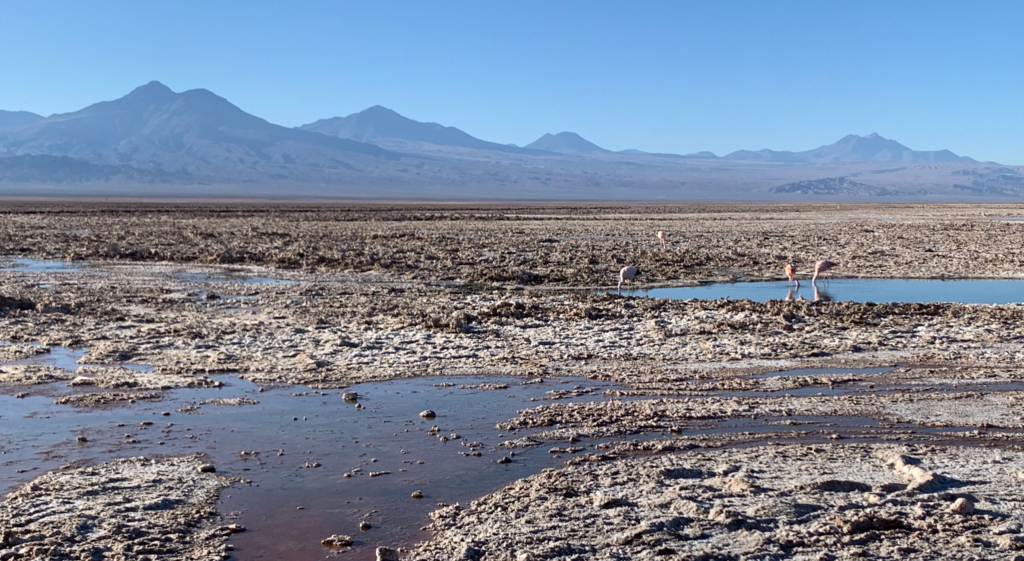
When we think of flamingos, we usually picture tropical settings, but this is far from that. The reserve is a desert oasis where shallow lagoons, formed by underground water sources, emerge from the desert floor. The water here is extra salty, which attracts crustaceans that flamingos feed on, making it a perfect feeding ground for these unique birds. There is something magical about seeing these creatures in this type of environment. It is a very unique experience. Plus, despite their reputation for having a strong odor, the flamingos here were spread out enough that we didn’t notice any unpleasant smells.
The ground around the lagoons is covered in unusual salt formations, adding to the surreal, almost alien appearance of the landscape. And while it was cold—around 40 degrees Fahrenheit—the sun was just beginning to rise, promising a warmer day ahead.
Side note: we visited in August, which is nearing the end of winter here. The average highs are in the mid-60’s Fahrenheit, which isn’t bad at all. However, it is cold when the sun is not out. The best times of year to visit are spring and fall. Summers do get hot, so if you’re escaping winter in the Northern Hemisphere, be ready.
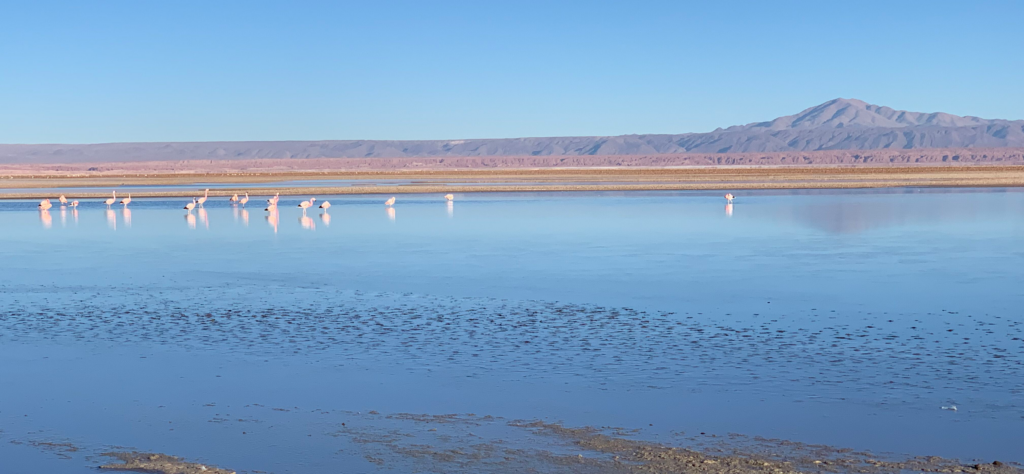
Breakfast on the Tropic of Capricorn
After our time with the flamingos, we hopped back in the van and continued our journey deeper into the desert. Our next stop was a simple, unassuming rest area along Route 23. However, it turned out to be one of the most memorable parts of the day. We had arrived at the Tropic of Capricorn. That’s the line of latitude that marks the southern boundary of the Earth’s tropical zone.
Here, in the middle of the Chilean desert, we had an impromptu picnic. Breakfast was simple but delicious: baguettes with scrambled eggs, cheese, and avocado. All of this prepared right there in the back of the van. Well, with the exception of the baguettes. Those were bought at an amazing French bakery before leaving San Pedro de Atacama. The bakery is owned by a Frenchman who moved to town and made amazing bread. So in turn, he started a bakery and distributes to many hotels and tour groups as well.
As we ate, a curious fox wandered nearby, eyeing our food with interest. It was one of those unexpected travel moments that stays with you long after the trip is over—a reminder that some of the best experiences happen when you least expect them.
After breakfast, came some social media moments. The road is a straight path down the middle of the highway, making a great picture spot. It kind of resembles the images of Forrest Gump running down the highway in the western United States. A lot of people get that pic, we know. We’d argue this spot is cooler, given the location.
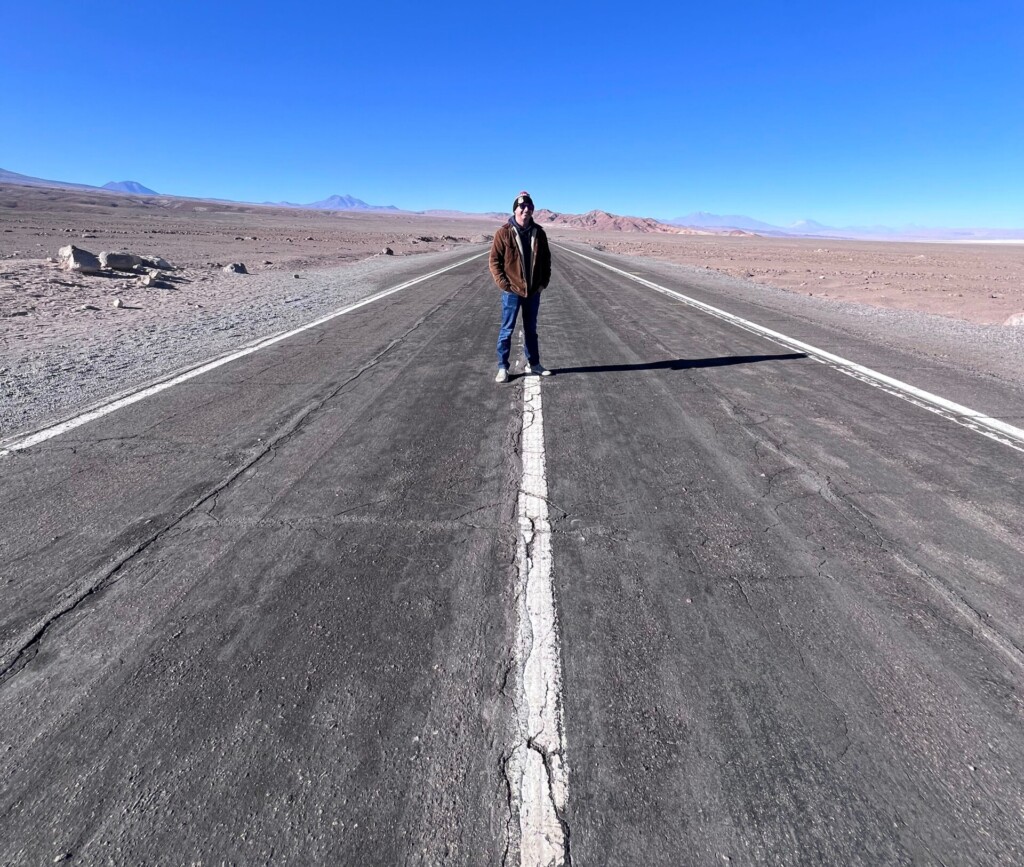
Laguna Miscanti: A Salty, High-Altitude Oasis
After breakfast, we continued our journey, climbing higher into the Andes on winding mountain roads. The landscape grew more rugged and the air thinner as we ascended to Laguna Miscanti, a deep blue, heart-shaped lake nestled beneath mountains rich in sodium nitrate, also known as white gold or Chile saltpeter.
The lagoon is fed almost entirely by groundwater, as parts of this desert have never had recorded rainfall. Surrounded by volcanoes on almost every side, the scene is breathtaking. The elevation here is over 13,000 feet, and the air is thin, making even a short walk feel like a workout. But the views are worth it—truly a sight to behold.
Standing on the shores of Laguna Miscanti, you can see for miles in every direction. The surrounding volcanoes, dormant for centuries, loom large against the horizon. Their jagged peaks cut a beautiful line into the clear blue sky. It does feel a little weird to take in such beauty, with at least 4 volcanoes in close proximity view. It’s a place that feels almost untouched by time, a serene oasis in the middle of one of the most arid environments on Earth.

Salar de Aquas Calientes: Salt Flats and the Red Rocks of the Atacama
From Laguna Miscanti, we made our way to our final stop of the day: Piedras Rojas, or Red Rocks at Salar de Aquas Calientes. This area is known for its striking red rock formations, which are set against the pale turquoise waters of a nearby lake. The wind here was fierce, nearly knocking us off our feet as we walked across the rocky landscape. We were told that the winds are anywhere typically between 50 and 100 km/hr here. So be ready for that if you come here. The colors were surreal—a vivid contrast of red rock, blue water, and white salt crusts that covered the ground.
It felt like stepping onto another planet. The rocks were formed by ancient volcanic activity, and their deep red color comes from iron oxide. The lake, meanwhile, is fed by underground springs and is so salty that it appears almost frozen, even though the water is perfectly still.
If you asked an artist to create the perfect backdrop for a social media picture, this is exactly what it would look like. The combination of colors and textures is mesmerizing, and it’s easy to see why this spot is so popular with photographers. It’s also why we took the opportunity to take a bunch of pics ourselves.
A Day to Remember in the Atacama Desert
As we were on the the way back to town, we took a moment to reflect on everything we had seen and experienced. The Atacama Desert is a place of extremes—a land of fire and ice, salt and sand, life and death. It’s a place that challenges you, inspires you, and leaves you with memories that will last a lifetime.
Starry Skies of the Atacama Desert
While in this beautiful wonderland, we knew night also brought amazing views. However, it’s a little different than nature. For this, we needed to look up.
The Atacama Desert is famous for its clear skies, making it one of the best places in the world for stargazing. There are several observatories in the area, such as the ALMA Observatory and the San Pedro de Atacama Celestial Explorations (SPACE), that offer guided stargazing tours. The lack of light pollution and high altitude provides incredible views of the Milky Way, planets, and distant galaxies.

No Light Pollution, Amazing Views
Experiencing the Atacama desert at night is truly a unique experience. There are few places, if any, that provide these views. The high elevation, lack of light pollution, and constantly clear skies are a perfect recipe for stargazing. There are a number of tours which pick you up in San Pedro de Atacama and bring you about 10 km outside town to take in the views. We have a lot more on this part of our adventure here.
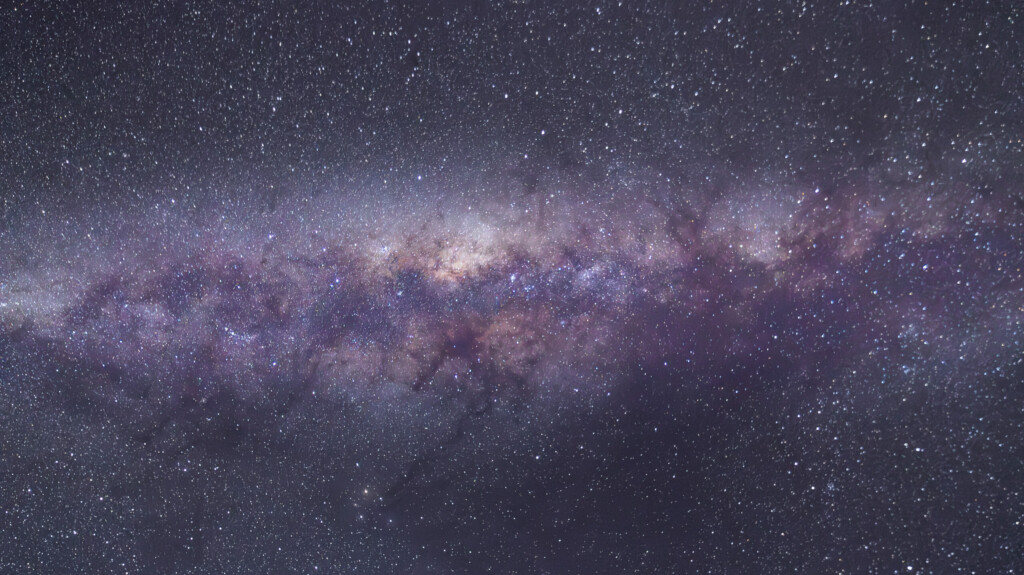
Once we arrived on location, it is very dark, and cold. Blankets are available, but dress warm for this. You will likely never see the stars this clearly again. The cloud of the Milky Way is in full view over your head while you enjoy a little wine and cheese. Plus, they will take professional long exposure pics that you’ll keep forever. You’ll also be able to see many cool sights thru the telescope, including an up close view of the moon and Saturn’s rings.
This is only a couple hours and very inexpensive cost. We may have been a bit chilly, but extremely thankful we decided to spend a night gazing at the stars in a way we never had before. And a way we never will forget.
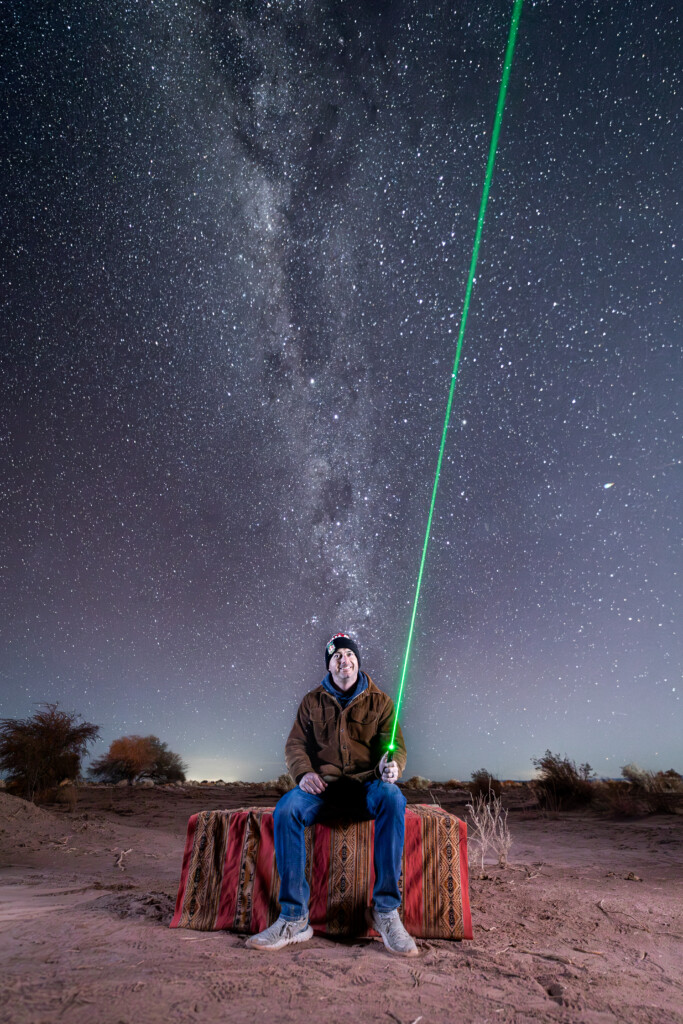
Our Other Recommended Atacama Adventures
If you’re going to come here, you’ll likely want to spend 3-4 days to see as much as you can. More than that might be a bit much, depending on the type of vacation you’re looking for. But that 3-4 day mark is likely the sweet spot, as you’ll want to probably see more of Chile.
Valle de la Luna (Valley of the Moon)
The Valley of the Moon is one of the most iconic sites in the Atacama Desert, known for its surreal, moon-like landscape. The area is filled with unusual rock formations, vast sand dunes, and salt caves. Some people come here to watch the sunset, as the changing colors of the sky dramatically transform the landscape. This is a very dusty location that kind of resembles the moon, so dress appropriately. Also, make sure you hike up to the top for the best views. The best time to visit is late afternoon, allowing you to explore before catching the stunning sunset views. This tour is only 4 hours, so easy to pack something into the morning before taking.
El Tatio Geysers
El Tatio is one of the highest geyser fields in the world, located at an altitude of over 4,300 meters (14,100 feet). The best time to visit is early in the morning when the geysers are most active. This creates an otherworldly scene with plumes of steam rising against the backdrop of the Andes. It will be cold here, so be prepared to deal with this. However, you can enjoy a hot bath in the thermal pools nearby after exploring the geyser field.
Explore the Rainbow Valley (Valle del Arcoiris)
The Rainbow Valley is named for its colorful hills, which are layered with mineral deposits that create vibrant hues of red, green, white, and yellow. The valley is a fantastic location for photography and hiking, offering a unique landscape that is unlike any other in the desert.
Thermal Springs of Puritama
The Puritama Hot Springs are a series of natural geothermal pools located in a canyon in the Atacama Desert. The thermal waters are rich in minerals and are believed to have therapeutic properties. It’s a perfect spot to relax and rejuvenate after a day of exploring the desert’s rugged terrain.
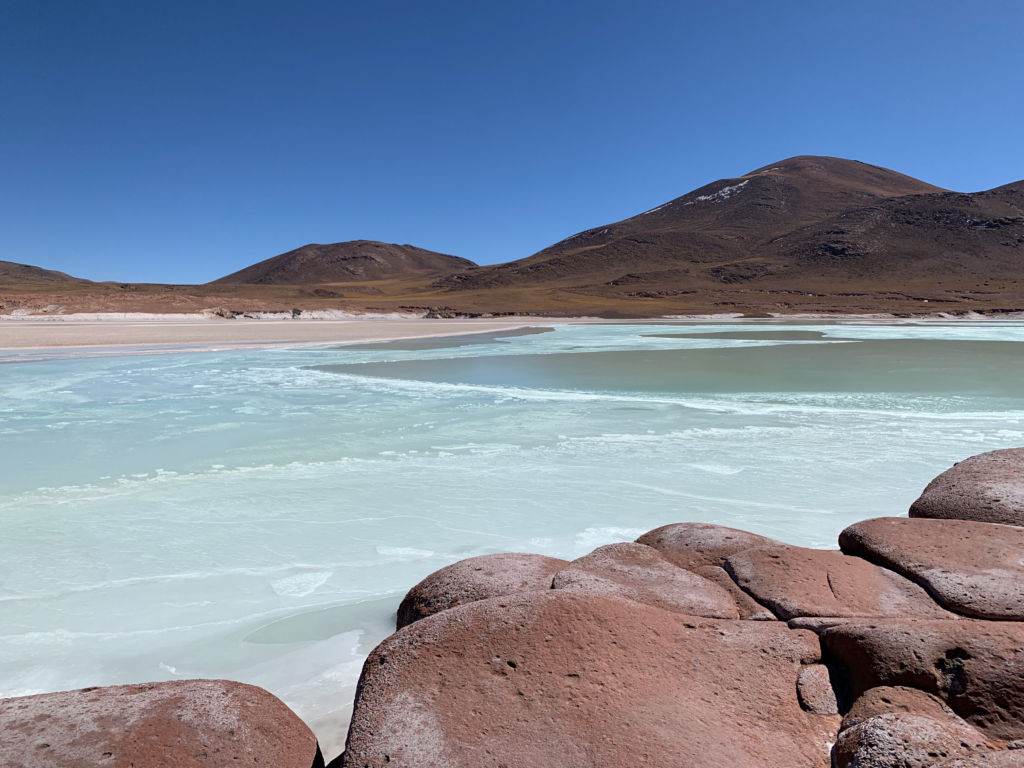
Where to Stay in San Pedro de Atacama
Now, San Pedro de Atacama is a very small town. But there are a number of hotels, all in close proximity to the central part of town. We stayed at the Nueva Lodge Estacion, due to the amazing reviews. However, it felt more like a hostel than a hotel. The host was very nice, the location was good, and the room was big. However, for the price, we feel could’ve chosen better. So we wanted to leave some options for you here below:
Tierra Atacama Hotel & Spa
This is THE high end place if you’re willing to spend the money. It has a luxurious and serene experience with a stunning view of the Licancabur Volcano. The hotel features beautifully designed rooms that blend modern comforts with local aesthetics. There’s an outdoor pool, spa services, and a variety of excursions tailored to explore the Atacama Desert. All-inclusive packages, excellent customer service, and sustainability practices.
Hotel Cumbres San Pedro de Atacama
This hotel is known for its comfortable accommodations and excellent service. It features spacious rooms with rustic decor, three swimming pools, a spa, and a restaurant serving regional cuisine. The hotel offers a relaxing atmosphere after a day of exploring the desert. Great value for money, spacious rooms, multiple swimming pools, and an on-site restaurant.
Altiplánico Atacama
This is a charming boutique hotel designed with local materials to reflect the culture and landscape of the area. The hotel offers simple yet elegant rooms, an outdoor pool, and several common areas for relaxation. This place has a unique design, intimate setting, and a tranquil environment.
Hotel Desertica
This hotel offers a mix of traditional Atacama style with modern amenities. The hotel is set within a peaceful oasis with a lovely outdoor pool, beautiful gardens, and cozy rooms. It provides a serene escape in the heart of San Pedro de Atacama. It has a very tranquil ambiance, excellent location, and beautiful gardens.
Hotel Kimal
This was very close to where we stayed and we kind of wish we’d had stayed here instead. Located in the center of San Pedro de Atacama, this place offers comfortable and eco-friendly accommodations. The hotel has an on-site restaurant, a pool, and offers various excursion packages. The rooms are designed in traditional adobe style, providing a cozy and authentic feel. It is very centrally located if you want to check out shops and local restaurants.
In Conclusion
For us, this was a place the was always on our bucket list. It’s a place that should be on everyone’s bucket list. This place is truly special and unique. It’s a destination that reminded us of why we travel in the first place: to see new places, to experience new things, and to create memories that we’ll carry with us forever. If you ever find yourself in Chile, we highly recommend spending at least a day—or more—exploring the wonders of the Atacama Desert. It’s a journey you’ll never forget.
